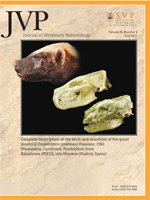Plotopterids are penguin-like, wing-propelled birds with controversial phylogenetic affinities. They are usually regarded as closely related to Suloidea (gannets, cormorants, and allies), with the penguin-like features considered to be of convergent origin. However, it has also been proposed that the similarities shared by plotopterids and penguins are due to common ancestry. An in-depth assessment of plotopterid affinities has been hampered by the fact that very little data about the skull of these birds were available. New fossils of Tonsala from the Oligocene Pysht Formation in Washington State (U.S.A.) include the first well-preserved cranial remains of this taxon. They show that although plotopterids share derived cranial features with members of Suloidea that are absent in species of Sphenisciformes (penguins), they lack diagnostic derived features of the representatives of crown group Suloidea. To assess the affinities of plotopterids, we performed a phylogenetic analysis that included, for the first time, early stem group representatives of Sphenisciformes, resulting in a sister-group relationship between Plotopteridae and Suloidea. Intriguingly, however, our reanalysis of the emended data of a more comprehensive recent analysis that supported a position of Plotopteridae within Suloidea recovered a sister-group relationship between Plotopteridae and Sphenisciformes. Although cranial morphology challenges the hypothesis of close affinities between plotopterids and penguins, more data on early stem lineage representatives of penguins are needed for a robust placement of Plotopteridae relative to Sphenisciformes.
How to translate text using browser tools
1 July 2015
Oligocene Plotopterid Skulls from Western North America and Their Bearing on the Phylogenetic Affinities of These Penguin-Like Seabirds
Gerald Mayr,
James L. Goedert,
Olaf Vogel
ACCESS THE FULL ARTICLE

Journal of Vertebrate Paleontology
Vol. 35 • No. 4
July 2015
Vol. 35 • No. 4
July 2015




